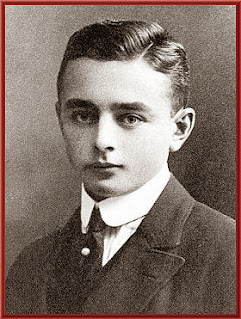Born in October 1887 in Hirschberg, Lower Silesia in what was then Prussia, Georg Heym is posthumously considered as one of the great figures of German Expressionism. Only in his early twenties, he penned several books of poetry, prose and drama including "Der ewige Tag (The Eternal Day)" in 1911 and "Umbra vitae" in 1912. What made his writing so interesting was that themes and metaphors that were considered prophetic by many, including the Nazis who later regarded his life's work as suspect. "The Eternal Day" used the metaphor a big city (in Heym's case Berlin) as a demon that destroyed humanity and his latter work "Umbra vitae", he wrote of an apocalyptic fantasy that later became the reality of World War I in "The War" and in "Death In Water" chillingly seemed to predict his own end almost like Jeff Buckley when he sang "I Know It's Over". Just as Buckley sang "Oh Mother, I can feel the soil falling over my head" predicting his death by drowning, Heym did the same in "Death In Water".
An unsatisfied student at Friedrich-Wilhelms-Gymnasium at Neuruppin in Brandenburg and the law school in Würzburg, Heym was by accounts a bit of a rebel, an individual in time when 'that sort of thing was frowned upon'. He wrote poetry as a means of expression while studying things that left him unsatisfied and even joined a Dead Poets Society style group called the Neue Club which was full of open minded thinkers who shared a sense of rebellion against the status quo, a disdain for contemporary culture and a desire for political and societal upheaval. The Neue Club held meetings much like the Dead Poets Society called Neopathetisches Cabaret where they presented new work and this is where Heym really started gaining attention and praise among his peers.
Natalie Merchant's song "It's A Coming" almost seems to echo Heym's ominous writing
UMBRA VITAE
Heym's 1912 prophetic poem, translated from German by Christopher Middleton:
"The people on the streets draw up and stare,
While overhead huge portents cross the sky;
Round fanglike towers threatening comets flare,
Death-bearing, fiery-snouted where they fly.
On every roof astrologers abound,
enormous tubes thrust heavenward; there are
Magicians springing up from underground,
Aslant in darkness, conjuring to a star.
Through night great hordes of suicides are hurled,
Men seeking on their way the selves they've lost;
Crook-backed they haunt all corners of the world,
And with their arms for brooms they sweep the dust.
They are as dust, keep but a little while;
And as they move their hair drops out. They run,
To hasten their slow dying. Then they fall,
And in the open fields lie prone,
But twitch a little still. Beasts of the field
Stand blindly around them, prod with horns
Their sprawling bodies till at last they yield,
Lie buried by the sage-bush, by the thorns.
But all the seas are stopped. Among the waves
The shops hang rotting, scattered, beyond hope.
No current through the water moves,
And all the courts of heaven are locked up.
Trees do not change, the seasons do not change.
Enclosed in dead finality each stands,
And over broken roads lets frigid range
Its palmless thousand-fingered hands.
They dying man sits up, as if to stand,
Just once more word a moment since he cries,
All at once he's gone. Can life so end?
And crushed to fragments are his glassy eyes.
The secret shadows thicken, darkness breaks;
Behind the speechless doors dreams watch and creep.
Burdened by light of dawn the man that wakes
Must rub from grayish eyelids leaden sleep."
Just as he predicted in his poem "Death In Water", at age twenty four Heym (an avid skater) and his friend Ernst Balcke would meet their end in water two years before the start of World War I. The two friends traveled to the frozen Havel (a tributary of the Elbe river in northeastern Germany) on a skating trip and never returned. A few days later, the bodies of both men were found and it is generally believed that Balcke had fallen through the ice and Heym had attempted to save his friend but fell in and perished in the cold water himself. Heym remained alive in the water for half an hour, his cries heard by nearby forestry workers that were sadly unable to reach him before he succumbed to hypothermia or drowning.
Gone too soon, John Curry's story and skating was like Heym's writing - ahead by a century.
This rebel, this brilliant writer and skating prophet's story almost harkens in my mind to the story of John Curry... a precocious rebel of convention of his times who left an indelible impression on the world around him and tragically left us too soon. One can only hope that the tragic losses of talented virtuosos in their respective crafts like Heym and Curry will continue to live on and influence the work of the wonderful rebels of generations to come.
Skate Guard is a blog dedicated to preserving the rich, colourful and fascinating history of figure skating. Over ten years, the blog has featured over a thousand free articles covering all aspects of the sport's history, as well as four compelling in-depth features. To read the latest articles, follow the blog on Facebook, Twitter, Pinterest and YouTube. If you enjoy Skate Guard, please show your support for this archive by ordering a copy of the figure skating reference books "The Almanac of Canadian Figure Skating", "Technical Merit: A History of Figure Skating Jumps" and "A Bibliography of Figure Skating": https://skateguard1.blogspot.com/p/buy-book.html.

